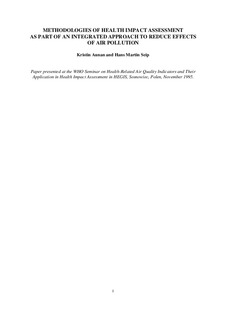| dc.contributor.author | Aunan, Kristin | nb_NO |
| dc.contributor.author | Seip, Hans Martin | nb_NO |
| dc.date.accessioned | 2014-03-17T14:31:08Z | |
| dc.date.available | 2014-03-17T14:31:08Z | |
| dc.date.issued | 1995 | nb_NO |
| dc.identifier.issn | 0504-452X | nb_NO |
| dc.identifier.uri | http://hdl.handle.net/11250/192186 | |
| dc.description.abstract | Quantification of average frequencies of health effects on a population level is an essential part of an integrated assessment of pollution effects. Epidemiological studies seem to provide the best basis for such estimates. This paper gives an introduction to a methodology for health impact assessment. It also gives results from some selected parts of a case-study in Hungary. This study is aimed at testing and improving the methodology for integrated assessment and focuses on energy production and consumption and implications concerning air pollution. Using monitoring data from Budapest, estimates of excess frequencies of respiratory illness, mortality and other health end-points are given. Concerning a number of health end-points, particles probably may serve as a good indicator component. Stochastic simulation is used to illustrate the uncertainties which are embedded in the exposure-response functions applied | nb_NO |
| dc.language.iso | eng | nb_NO |
| dc.publisher | CICERO Center for International Climate and Environmental Research - Oslo | nb_NO |
| dc.relation.ispartof | CICERO Working Paper | nb_NO |
| dc.relation.ispartofseries | CICERO Working Paper;1995:07 | nb_NO |
| dc.title | Methodologies of health impact assessment as part of an integrated approach to reduce effects of air pollution | nb_NO |
| dc.type | Working paper | nb_NO |
| dc.source.pagenumber | | nb_NO |
